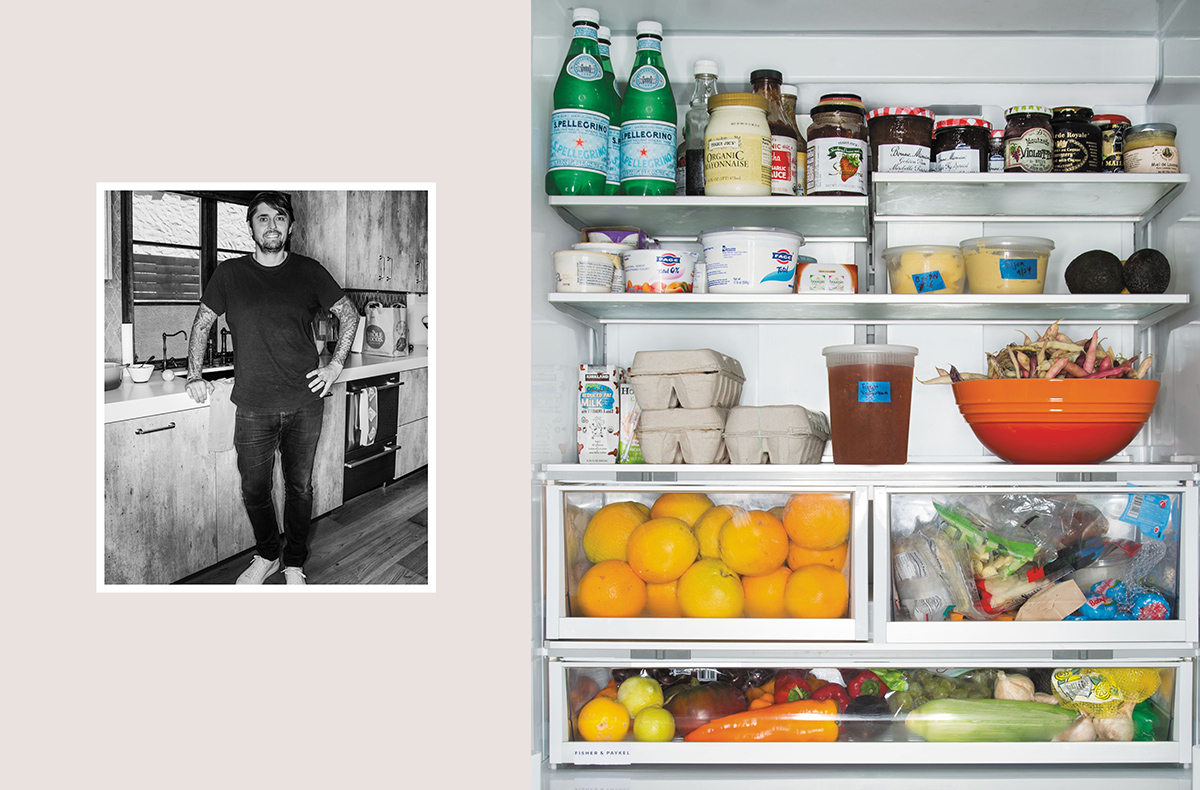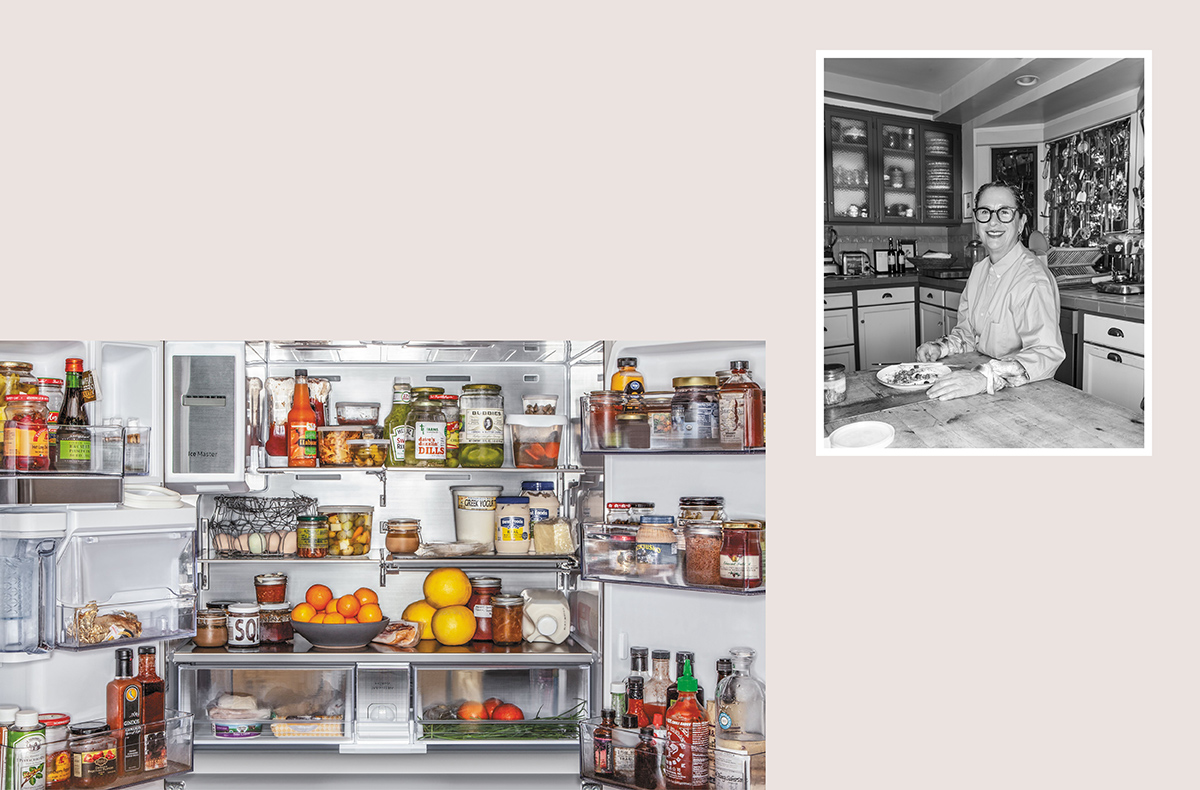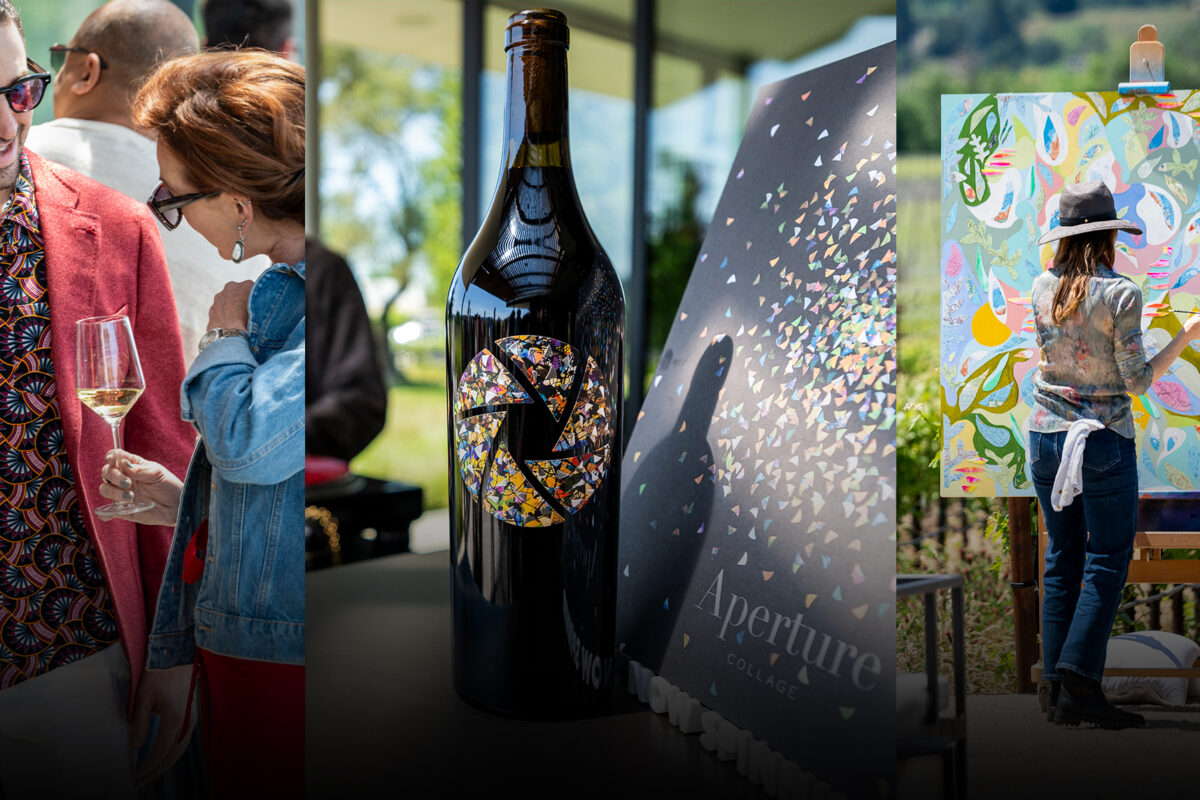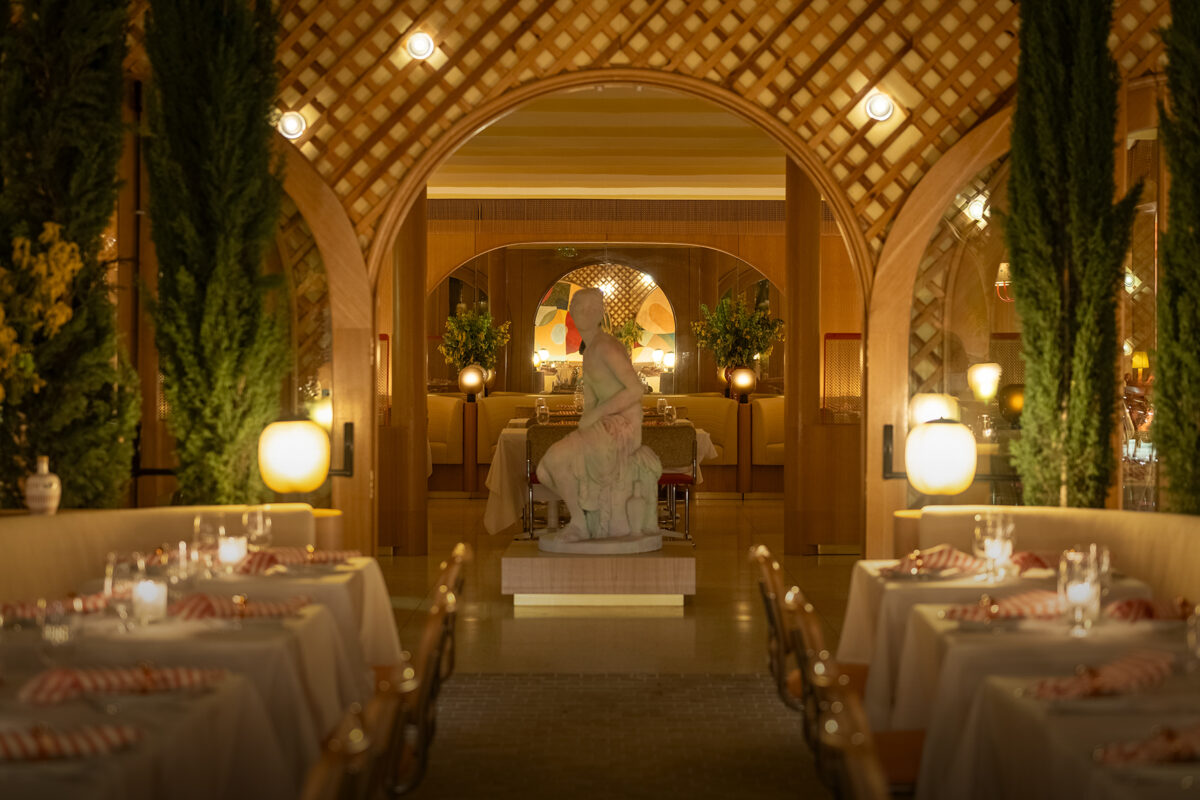What’s on the shelves is a window into the soul
Introduction by FLORA TSAPOVSKY
In quarantine, we’ve developed new relationships with our fridges and pantries. We’re obsessed with sourdough starters, learning pasta from scratch, and with summer’s arrival, pickling and preserving as much as we baked back in March. While our own fridges continue to fascinate, even more intriguing are the contents of others’. A fridge is a window into one’s soul: a tell-all about one’s idiosyncrasies, affinities and whims.
So we jumped at the chance to peek into those belonging to California’s favorites. In a new book by Carrie Solomon and Adrian Moore, simply named Chefs’ Fridges (Harper Collins, $40). leading US restaurateurs from coast to coast open their aluminium doors, including those behind Trois Mec and Chi Spacca in L.A. and Atelier Crenn in San Francisco, below. As they spill their culinary secrets and wax poetic about arcane ingredients, these masterful visionaries, whose food we’ve adored in our dining-out days, reveal their guilty pleasures and home-cooking philosophies.
• • • • •
DOMINIQUE CRENN
Atelier Crenn, San Francisco
Although Dominique Crenn knew she wanted to be a chef from age eight, her parents dissuaded her. But after getting degrees in economics and international business in Paris, she landed in San Francisco, where the first thing she did was seek out the best chef in town. That happened to be Jeremiah Tower, whose restaurant Stars was the most famous in the city at that time. Crenn, with no references or cooking qualifications, simply walked in the front door and asked for a job, and that evening she was manning the grill for a full house. In 2011, she opened Atelier Crenn, which was dedicated to the memory of her father. She quickly earned a Michelin star, then a second, then, historically, a third — and opened several more restaurants. Although running four eateries is hectic, her kitchen at home that she shares with her wife is a respite. “My style comes from always being open to looking at food in different ways, being inspired by others, and learning new things through connections and dialogue,” she says. “Always evolving.”
This is the smallest refrigerator — it’s just a drawer in the wall. How were you able to switch to such a small fridge?
It helped me to be more conscious and thoughtful. What we had before was so big and often so empty. We realized it’s a question of waste. When you are a chef you cook what arrives every day. I don’t cook something that has been there for ten days and at the supermarket for already a month. After all, what is the idea of a refrigerator? To keep things cold. But it became something where the bigger the fridge the cooler you are. In the supermarket you see now that they create double packs or triple packs, and it’s all buy one, get two for free. … You can see that consumption is doubling and tripling. At Atelier Crenn we have a small kitchen and a small fridge. I think the new ideas for kitchen design are going to get more compact.
Did it take time to get used to pulling out a drawer instead of opening a door?
Not really. It’s only tricky when we want to cook large meals. When my wife’s family of fourteen was in town for Christmas Eve we had to prepare the dinner at the restaurant and then bring all the food here.
Do you bring back food from France?
I bring back cheese — but I’ve been caught at customs and they have taken everything away.
And the sheep’s butter? Can you use it like regular butter from cows?
It’s absolutely delicious. For me it’s so much better than the cow’s milk. We live in a world where milk is not milk anymore. Cows being milked 24/7 is not natural. And the cattle industry in the U.S. is disgusting. I have found a couple of local yogurts though. And butter from Brittany is special; it’s the best butter in the world. Are the pâté and saucisson sec from France? No, they are from a local company. Food is energy and this is one I want to support. We need to care about our animals. I am not saying we need to be vegan but we need to balance everything.
How often do you go food shopping?
We go to Good Earth Natural Foods store on the weekends and we bring things back from the farm. Larkspur, the town closest to us, also has a nice farmers market.
Any exceptions when it comes to food?
I don’t believe in junk food.
But your wife said something about nachos, right?
They are for my wife. I eat them sometimes too, but without the spice.
• • • • •
LUDO LEFEBVRE
Trois Mec, Petit Trois and Trois Familia, Los Angeles
Ludo Lefebvre has come a long way from Auxerre, the town in rural France where he was born and raised. Now the proprietor of various restaurants and a TV show host, he was a high school delinquent whose cooking career started thanks to his father. “My dad gave me three choices: hairdresser, mechanic, or cook. I loved to eat, so I chose to cook.” Lefebvre got his first chance when his mentor, Marc Meneau, who oversaw his kitchen training in France, convinced him to go to America and make money. Meneau helped him with contacts, but despite offers from Daniel Boulud and Charlie Trotter, Lefebvre chose to work at L’Orangerie in L.A., because, of all things, he was a Baywatch fan: “The lifestyle seemed so amazing, so I thought, why not?” But he became frustrated with the fine dining world and began to cook on his days off in a baker friend’s kitchen, virtually inventing the L.A. pop-up concept in the process with a series of online-booking-only surprise dinners. Stellar reviews in The New York Times and especially by Jonathan Gold in the Los Angeles Times brought things to a fever pitch. Soon investors came knocking, resulting in a series of successful brick-and-mortar establishments, such as Trois Mec, Petit Trois, Trois Familia and, Lefebvre’s dream, a fried-chicken franchise. Running a small empire can have its downsides. “I typically don’t eat when I get home unless my wife and kids leave me a box of cold pizza sitting in the fridge,” he says. But then again, he’s not complaining about being at the center of the California culinary scene: “It was like lightning in a bottle, and I found out the kitchen is my happy place.”
Any childhood food memories?
It may sound strange to Americans, but one of my favorite things to eat as a kid was escargots. I used to eat them like they were M&M’s. I’ve eaten over a hundred in a day!
What about dishes your mother made for you?
I used to love when she made me hachis parmentier [shepherd’s pie] and ratatouille, and my favorite was when she made her special chocolate cake.
Do you cook often for your family at home?
Family mealtime is important, but because of my obligations to my restaurants, I can’t always be at home at night, so we have breakfast together every day. Sometimes it’s toast, sometimes baguettes, sometimes we all have cereal; but we all eat together in the morning as a family.
What do you like to cook when you do have time?
Because we live in California, we do a lot of barbecuing outside, fresh-grilled meats and vegetables. Nothing complicated, just fresh. We also have crepe nights. I just cook up a bunch of crepes, both savory and sweet, and everyone gets to make their own dinner and dessert.
Do you ever miss the food of France?
California is the best in the world for fresh produce. But I will always take the cheese and butter of France over any other!
There seems to be a lot of cheese in your refrigerator!
I am French. I wouldn’t believe any person who says they are French and doesn’t buy a large selection of cheese. Cheese is a big part of the everyday. We use Havarti and white cheddar on sandwiches for the kids [his twins, Luca and Rêve] and string cheese and Babybel as snacks for lunch boxes. My wife, Kris, seems to have a plate of cheese, salami, and crackers on her desk almost every day. Many times when I come home from work late at night or midafternoon on a day off I am guilty of eating a few pieces of string cheese or Babybel just plain. I justify it as a good source of protein.
What is your favorite junk food?
I am torn between Pringles and Kit Kats or Twix.
• • • • •
NANCY SILVERTON
Pizzeria Mozza and Osteria Mozza, Los Angeles
Italy has been an inspiration for Silverton forever — it’s the place where she goes when she leaves one restaurant for another, opens up a new establishment, or, once, after her divorce. Why Italy? “Everyone was going to Provence, or if they went to Italy they went to Tuscany,” she explains. “So we went to Umbria. It was a lot less expensive.” Silverton even bought a house in the Umbrian countryside so she could search out local bread makers, the best tomatoes, olive oil, and anchovies for her restaurant. If she has a mantra, it’s this: “I know what I like to eat, and apparently it’s what a lot of other people want to eat too.” It’s the same approach she takes to her restaurants and the backyard entertaining she does. When she recently got a new refrigerator — a high-tech smart one by Samsung — she knew that she had to hold on to the old one too: “Growing up, my friends’ parents often had a refrigerator in the garage and that was their drink refrigerator.”
The first things I see in the refrigerator are condiments. Why so many?
Condiments last—I have three grown kids but they no longer live with me, so I no longer have the responsibility of keeping food with a short shelf-life. When I’m home and ready to entertain, then I’ll go out to shop for those items. I host half a dozen big parties here a year, and good condiments give you flavor with little effort. I often doctor things up and reason. I use simple mayonnaise and then flavor it with chipotle to make a spicy mayo or use some fresh grated garlic, olive oil, and lemon to make an aioli. I use the condiments as a base.
When you have a food craving do you reach for savory or sweet?
Savory.
What is your eating style at home? Snacking on anchovies and small plates?
Sometimes after a shift at Mozza, I’ll stand by the sink and eat a snack. Maybe some pistachios from Syria. Maybe some bread and Rodolphe butter. That with red wine? Heaven.
Something we’d never find in your fridge?
I never have takeout containers. Don’t get me wrong, I love leftovers, but as soon as I come home from a restaurant, I take them and put them in a home container.
Anything else?
Margarine. The French butter I have always in the fridge—Rodolphe le Meunier beurre de baratte with fleur de sel—would kick the margarine’s ass. And would kick other butters’ asses as well.
Have you ever had your own chickens?
We used to have chickens in our backyard and then I put in a pool. That coincided with the dog eating the last chicken and my getting divorced. My youngest loved the chickens. They were heritage breeds and laid a gamut of different colored eggs. It was great, we would be baking and realize we needed eggs and we would just run out back to get some.
Do you enjoy shopping for food?
I love going to grocery stores in Italy. It’s an adventure. Half the stuff I don’t know what it is. It’s less fun here.
Do you bring back condiments from Italy?
When I travel I bring back condiments, crackers, and cheese. I’m an anchovy fanatic. I love cured anchovies. But I can’t bring those fantastic cured meats back. On the record I can’t say I’ve ever smuggled back a large ham in my suitcase — I will leave that answer open-ended.
Chef introductions and interviews excerpted and adapted from Chefs’ Fridges (Harper Collins, $40) by Carrie Solomon and Adrian Moore.
Feature image: NANCY SILVERTON’s fridge. All photos by Carrie Solomon.
May 21, 2020
Discover more FOOD news.







